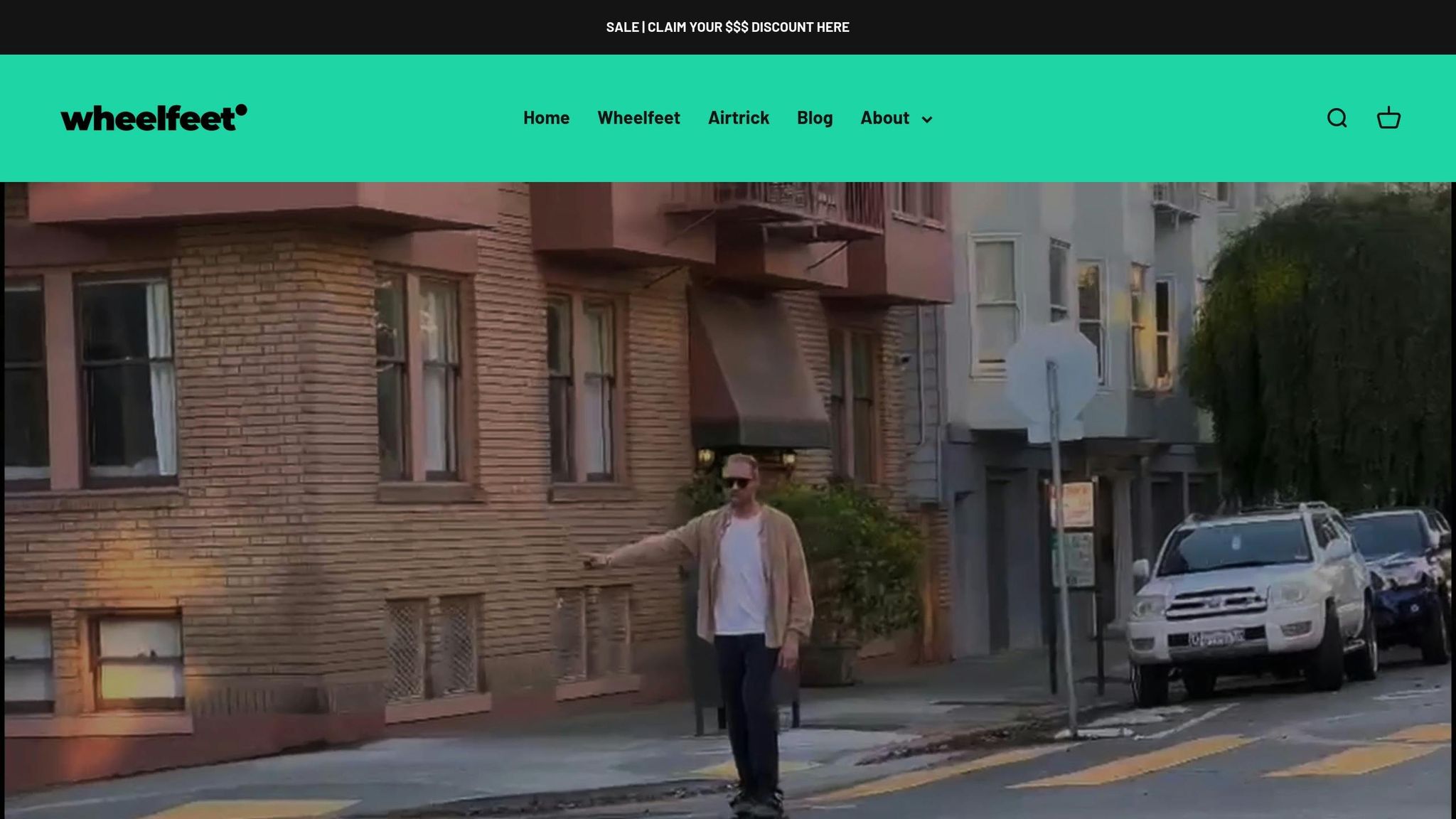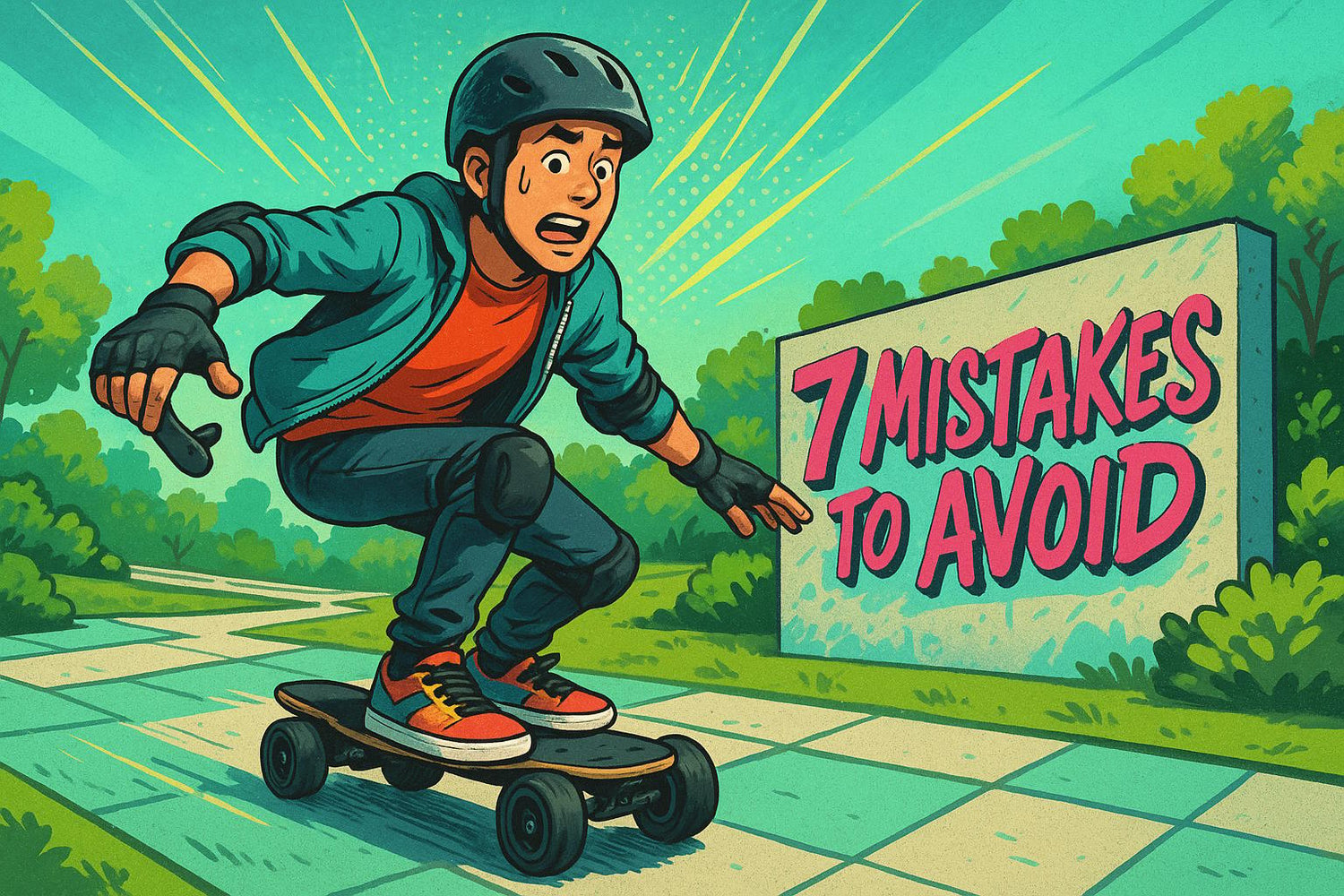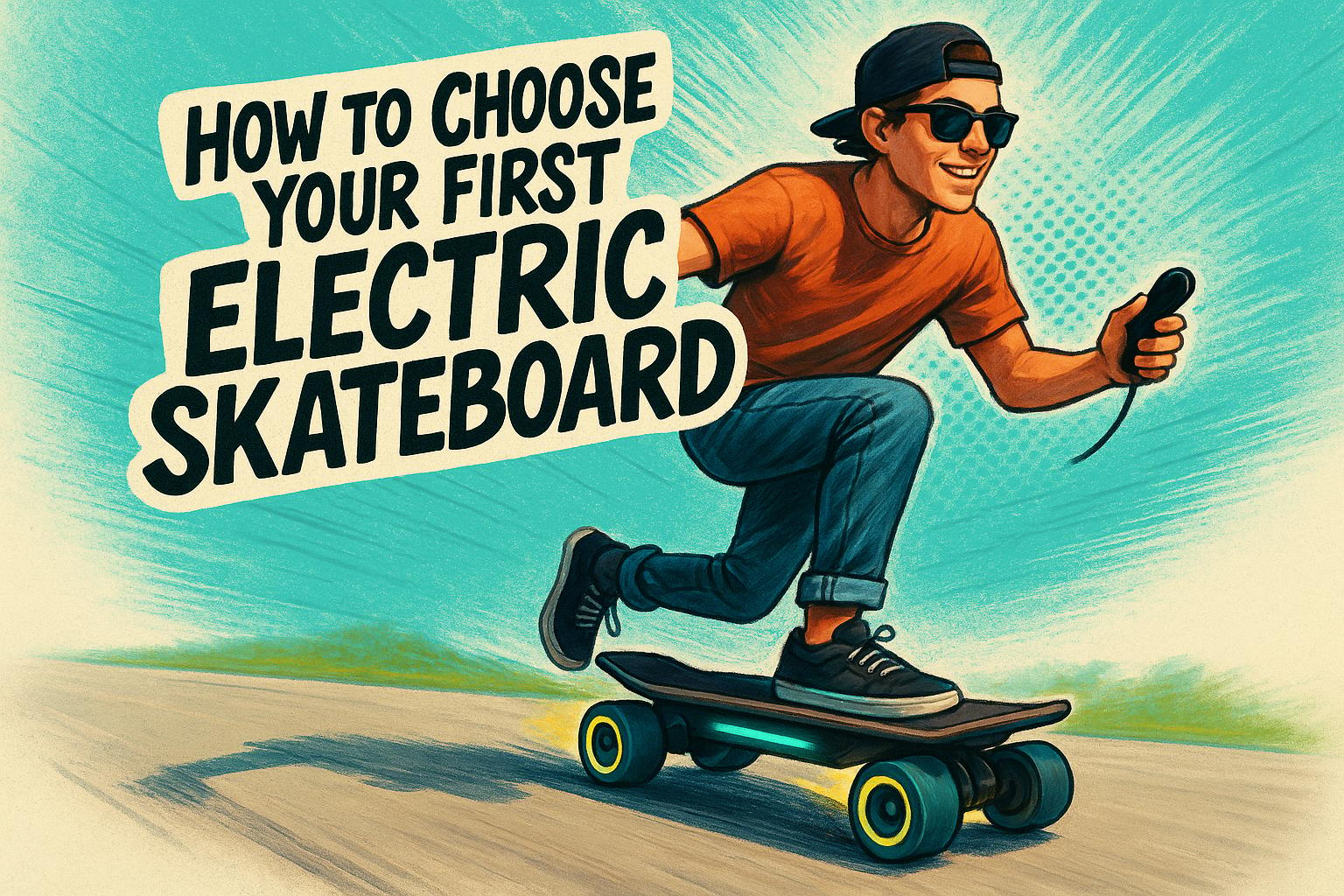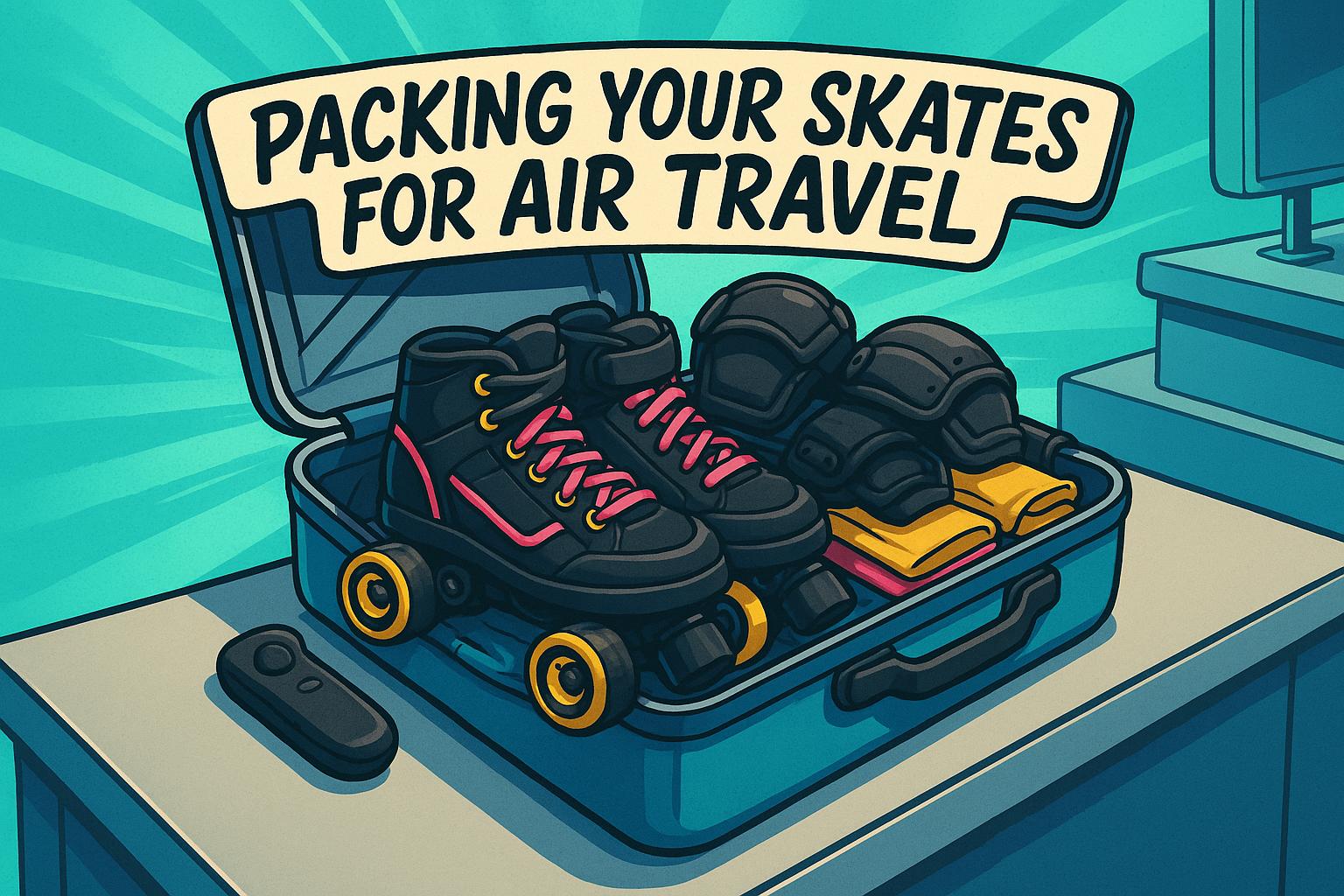Electric skateboards are a fun and efficient way to get around, but your first ride can be risky if you're not prepared. Many beginners make avoidable mistakes that lead to falls, injuries, or frustration. This guide highlights the seven most common errors and how to avoid them:
- Skipping Safety Gear: Not wearing a helmet or pads can turn a small fall into a serious injury.
- Poor Stance and Balance: Incorrect foot placement can make steering and braking harder.
- Going Too Fast Too Soon: Starting at high speeds often leads to loss of control.
- Ignoring Equipment Checks: Overlooking things like battery levels or loose screws can cause accidents.
- Riding in Unsafe Areas: Bumpy surfaces, heavy traffic, or wet conditions are dangerous for beginners.
- Breaking Laws: Not knowing local rules can lead to fines or unsafe riding practices.
- Losing Focus While Riding: Distractions like phones or loud music increase the risk of accidents.
15 Mistakes Beginner Electric Skateboarders Make
Mistake 1: Not Wearing Safety Gear
Skipping safety gear might not seem like a big deal - until it is. A fall at speeds of up to 15 mph can lead to serious injuries if you're not properly protected. Making safety gear a priority is the first step toward avoiding other common riding mistakes.
Essential Safety Gear You Need
Start with a helmet. It should sit level on your head, covering your forehead with the bottom edge about one to two finger-widths above your eyebrows. The straps should form a snug "V" shape just below your ears, and the helmet should stay secure even when you move around. A properly fitted helmet isn’t just a suggestion - it’s your best defense against head injuries. Setting yourself up with the right safety gear ensures every ride feels safer and more enjoyable.
How Wheelfeet’s Design Supports Safety

Wheelfeet’s thoughtful design features - like a wireless remote control, regenerative braking, adjustable speeds, and a lightweight frame - help riders feel in control and confident. But even the smartest design can’t replace the protection of a good helmet. Safety gear will always be your first line of defense.
Mistake 2: Wrong Stance and Poor Balance
Your stance is the backbone of your electric skateboarding experience. If your stance is off, it can throw your balance, steering, and confidence completely out of sync.
How to Find Your Correct Stance
When it comes to stance, there are two main types: Regular (left foot forward) and Goofy (right foot forward). Interestingly, your hand dominance has nothing to do with which stance feels natural to you. Research shows that around 55–60% of skaters ride regular, while 40–45% lean toward goofy.
How to Keep Your Balance
Balance begins with proper alignment. Place your front foot near the front trucks to guide your steering, and position your back foot over the rear trucks for stability. Bend your knees slightly - this acts as a natural shock absorber. Shifting your weight slightly forward improves control, especially when steering or braking. To maintain smooth control, keep your upper body centered over the board.
Take your time practicing until your stance and balance feel automatic. A proper stance not only improves how you steer, accelerate, and brake but also minimizes physical strain, making your rides more comfortable and enjoyable. Getting this right is a crucial step toward confidently managing speed and control.
Mistake 3: Going Too Fast Too Soon
Once you've got your safety gear on and your stance sorted, the next big challenge is resisting the urge to speed up too quickly. Speed can be thrilling, but for beginners, it often leads to losing control and confidence. Pushing yourself too hard before nailing the basics can result in accidents or injuries.
Controlling speed isn’t just about going fast - it’s about mastering how to accelerate and slow down with precision. Skipping this learning phase means your reflexes and muscle memory won’t be ready to handle sudden obstacles or changes in terrain. Starting slow helps you build the control and skills needed for more advanced riding.
Start with Low Speed Settings
Always begin with the lowest speed setting or beginner mode. Many experienced riders suggest practicing in these modes for at least 10–20 hours before moving to faster settings. Use this time to focus on the essentials: smooth steering, controlled braking, and maintaining balance during turns.
Low-speed settings give you more reaction time and better control. This is especially important when unexpected situations arise - like dodging a pothole, avoiding a pedestrian, or stopping suddenly. Slower speeds are perfect for practicing braking techniques. Find an empty parking lot and work on gradual stops, emergency braking, and controlled deceleration. Experiment with different braking pressures to understand how your board responds in various scenarios.
Smooth Speed Changes vs Quick Movements
Once you’re comfortable at lower speeds, the focus shifts to smooth transitions. Sudden acceleration or harsh braking can quickly throw you off balance and lead to loss of control. Jerky throttle movements might cause your wheels to lose traction or destabilize your ride.
Gradual acceleration keeps you in control and improves overall performance. By easing into the throttle, you maintain better traction and keep your center of gravity steady, which reduces the risk of wobbling. The same principle applies to braking - gentle deceleration keeps you stable and prevents skidding, while abrupt stops can lock your wheels or cause you to lurch forward.
For better speed management, lean slightly forward to lower your center of gravity. This stance enhances stability and helps you maintain control. Keep your knees bent and your weight centered over the board for added balance.
Think of it like navigating city traffic - smooth acceleration, gradual braking, and staying aware of your surroundings. Jerky movements not only put your safety at risk but also reduce your board’s efficiency and the overall quality of your ride.
Lastly, let your current skill level and riding conditions dictate your speed. Just because your board is capable of high speeds doesn’t mean you should push it in every situation. Build up to faster speeds and tougher terrain as your confidence grows naturally.
Mistake 4: Skipping Equipment Checks Before Riding
It’s tempting to hop on your electric skateboard and hit the road right away, but skipping a quick equipment check can set you up for trouble. Neglecting this simple step could lead to mechanical failures, unexpected breakdowns, or even accidents that could’ve been avoided with just a few minutes of preparation. Think of it like checking your car before a road trip - it’s all about safety and reliability.
Equipment failures don’t just risk your safety; they can also damage your board and leave you stranded. Taking the time to inspect your board regularly can help you catch small problems early, saving you from costly repairs and potential mishaps. A quick pre-ride check is just as important as wearing the right gear or maintaining proper riding posture.
What to Check Before Each Ride
- Battery Levels: Check the charge on both your board and remote. For longer rides, bring along the remote’s charging cable. A dead remote mid-ride can leave you unable to brake or control your speed, which can be incredibly dangerous.
- Wheels: Look for signs of wear, cracks, or debris stuck in the treads. Spin the wheels by hand to ensure they rotate smoothly. Worn wheels can reduce traction, making turns and braking harder to manage.
- Hardware: Tighten all screws, nuts, and bolts, especially the ones holding your trucks to the deck. Loose hardware can cause wobbling or steering issues and may even fail during a ride.
- Deck and Belts: Check the deck for cracks or signs of damage. If you have a belt-driven board, inspect the belts for fraying, missing teeth, or improper tension. Even small cracks or belt issues can worsen quickly under the stress of riding.
- Brakes: Test your brakes in a safe, controlled area to ensure they’re functioning smoothly and without any unusual noises.
Wheelfeet's Built-in Reliability
Wheelfeet boards are built with durability and dependability in mind. Their aluminum frames and high-quality components are designed to handle regular use with ease. Features like regenerative braking not only provide consistent stopping power but also help extend battery life. Plus, the dual-mode design lets you manually propel yourself if an electrical issue arises.
Even though Wheelfeet boards are built to last, regular safety checks are still essential. Mechanical wear and tear are inevitable, and with powerful motors capable of speeds up to 15 mph, even minor issues can escalate if left unchecked. Taking the time to inspect your board helps you stay ahead of potential problems, making your rides safer and more enjoyable.
The more familiar you become with your board, the easier it will be to recognize normal wear and spot anything out of the ordinary. Over time, these quick pre-ride checks will become second nature, giving you the confidence and peace of mind to focus on the ride ahead. A few minutes of preparation can make all the difference in ensuring your board is ready for whatever the road throws at you.
sbb-itb-bf837b9
Mistake 5: Riding in Dangerous Places
Where you choose to ride your electric skateboard can have a huge impact on your experience as a beginner. Many new riders underestimate the risks posed by their surroundings. Uneven surfaces, heavy traffic, and unexpected obstacles can quickly turn what should be a fun learning experience into a dangerous one, especially when you're still getting the hang of balancing and controlling your speed.
Electric skateboards are faster and heavier than traditional boards, requiring more precise handling. A route that feels safe while walking can become risky at higher speeds. Starting out in the wrong environment not only increases the chance of accidents but can also dent your confidence and slow your progress. A single nerve-wracking ride on a busy street or bumpy terrain might make you think twice about getting back on the board. Picking a safe place to practice is just as important as wearing the right gear and mastering basic techniques.
Best Places for New Riders to Practice
If you're just starting out, stick to controlled environments where you can focus on building your skills. Empty parking lots are a great option. Look for smooth asphalt with no potholes, debris, or slippery painted lines. Shopping centers, schools, and office buildings often have large, flat parking areas that are perfect for practicing turns and stops. Early mornings or evenings usually offer the most space with minimal distractions.
Once you're comfortable with the basics, paved bike paths and greenways are excellent next steps. These paths are typically smooth and designed for wheeled traffic, making them safer than sidewalks or busy roads. Many cities have recreational paths with gentle slopes and wide curves, ideal for practicing speed control and steering.
Tennis and basketball courts also provide safe, predictable surfaces. The clearly marked boundaries can help you practice turning and stopping within a confined area. Community centers and schools often allow access to their courts during off-peak hours, giving you a chance to work on advanced skills like carving and emergency braking.
For intermediate riders, quiet residential streets with little traffic can be a good option. Look for streets that are wide and have good visibility. Avoid areas near schools, playgrounds, or intersections with frequent activity. Cul-de-sacs are particularly great since they naturally limit through traffic.
Dangerous Conditions to Stay Away From
Certain conditions are especially risky for electric skateboard riders, and beginners should avoid them altogether. Wet or damp surfaces are a top hazard. Even a small amount of moisture can make the ground slippery, making it hard to brake or maintain control during turns. Painted crosswalks, manhole covers, and metal grates become even more treacherous when wet.
Steep downhill slopes are another no-go for beginners. Gravity can quickly increase your speed, and controlling your board on declines requires skills that take time to develop.
Busy areas with heavy traffic - like downtown streets, commercial zones, and intersections - pose multiple dangers. Cars, pedestrians, and cyclists all move at different speeds and often don't anticipate electric skateboard riders. Parking lot entrances and driveways can be especially risky, as drivers may not see you coming.
Avoid rough surfaces like cracked sidewalks, gravel paths, and cobblestones. These can throw off your balance and lead to falls.
Finally, low-light conditions such as dawn, dusk, or nighttime riding can make it harder to see obstacles and reduce your visibility to others. Beginners typically lack the experience and equipment needed to navigate these environments safely, so it’s best to save nighttime rides for when you’re more confident in your skills.
Mistake 6: Ignoring Laws and Riding Rules
A lot of new electric skateboard riders assume they can go wherever a regular skateboard does, but that’s not always the case. Rules for electric skateboards vary depending on your state, city, or even county, and ignoring these regulations can lead to fines - or worse.
Depending on where you live, electric skateboards might be classified as motor vehicles, bicycles, or even their own category. This classification determines where you’re allowed to ride, what safety gear you need, and what speed limits you must follow. Some areas may require you to stick to the road, while others allow sidewalk riding. Knowing the rules in your area isn’t just about avoiding penalties - it’s also about staying safe and riding responsibly.
These laws often exist for good reasons. Helmet requirements, speed restrictions, and other rules are designed to address real safety concerns, especially in areas with heavy pedestrian traffic. Once you understand what’s expected of you, you’ll be better equipped to choose the right places and times to ride and to navigate shared spaces safely.
Electric Skateboard Laws in the U.S.
Navigating the legal side of electric skateboarding in the U.S. can be tricky because the rules change depending on where you are. Each state, city, and county has its own regulations, so before you hit the streets, it’s crucial to do your homework.
For example, helmet laws differ widely. Some places require helmets for all riders, while others only enforce this rule for minors. Speed limits are another thing to look out for - many areas set specific caps, with lower limits often in place near schools or in busy downtown zones. Additionally, some regions require front and rear lights or reflective gear, especially if you’re riding at night or in low-light conditions.
To stay on the right side of the law, start by checking your city’s official website for traffic or transportation regulations. Your state’s Department of Transportation is another helpful resource. And if you’re still unsure, call your local police department’s non-emergency line for clarification.
How to Share Space with Others
Knowing the law is important, but responsible riding goes beyond just following the rules. How you interact with pedestrians, cyclists, and drivers plays a big role in keeping everyone safe and in shaping how others view electric skateboarders.
Always give pedestrians the right of way and slow down in crowded areas. A walking pace of around 5–7 mph is a good guideline when navigating busy sidewalks or shared spaces. This is especially critical since 68% of U.S. adults believe skateboards belong on the sidewalk.
Visibility is another key factor. Use lights and reflective gear when riding during low-light hours, and consider wearing bright clothing even during the day to make yourself more noticeable to drivers and cyclists. Stick to a predictable path and yield when necessary to avoid sudden surprises.
When sharing bike lanes with cyclists, be extra mindful. These are shared spaces, so give cyclists plenty of room and avoid making abrupt movements. A little courtesy goes a long way in keeping everyone safe.
Lastly, respect private property and areas with specific rules. Many shopping centers, office complexes, and private neighborhoods have their own policies about wheeled vehicles. Even if local laws allow electric skateboards, property owners might have stricter rules. When in doubt, ask for permission or choose another route.
Mistake 7: Not Paying Attention While Riding
One of the riskiest errors new electric skateboard riders make is losing focus while cruising. Unlike traditional skateboards, electric models can hit higher speeds and need more distance to stop, so even a brief moment of distraction can have serious consequences.
Activities like checking your phone, cranking up music, or letting your mind drift can be downright dangerous. Even a split second of inattention might result in unexpected challenges - think a pedestrian suddenly crossing your path, a car door swinging open, or an obstacle appearing out of nowhere.
Traffic, in particular, is unpredictable. Pedestrians, vehicles, cyclists, and even animals can act unexpectedly, making it critical to stay alert and ready to respond at any moment.
Here’s how to keep your focus sharp while riding.
How to Stay Alert While Riding
Start by eliminating distractions. Don’t use your phone while riding; if you need to check it, stop in a safe spot first. If you’re listening to music, keep the volume low or use just one earbud so you can still hear important sounds like approaching cars or horns.
Make it a habit to scan your environment. Look ahead, to the sides, and, when safe, behind you. Watch out for hazards like loose gravel, wet patches, or uneven pavement. Avoid carrying items in your hands, as they can throw off your balance. Instead, use a snug backpack that won’t shift as you ride.
Pay attention to anything unusual. Whether it’s a pedestrian acting unpredictably, a car swerving, or a cyclist weaving, trust your instincts. Slow down and give yourself extra space rather than trying to maintain your speed and risking an accident.
Just like wearing the right gear protects your body, maintaining focus protects you from unexpected dangers. Staying sharp ensures you’re always ready to react, making your rides safer and smoother.
Why Focus Matters for Safety
Staying focused is essential because the environment around you can change in an instant. Even a brief lapse in attention can cost you the chance to avoid a hazard. Being consistently aware helps your brain process sudden changes and coordinate your reactions effectively.
The faster you go, the more crucial this becomes. Your concentration and reflexes work together to help you adapt to subtle shifts in your surroundings - whether it’s a pedestrian stepping out or a car slamming on the brakes ahead.
"The electric skateboard rider's greatest tool is their undivided attention - it enables quick response to surprise obstacles and contributes to a safer, more enjoyable ride."
With time and experience, staying alert becomes second nature. As you build confidence, you’ll naturally start scanning for hazards, anticipating movements, and adjusting your speed and stance. But even seasoned riders need to avoid complacency, especially on routes they know well.
Take this focus with you on every ride - it’s your best defense against the unexpected.
Conclusion: Start Your Electric Skateboard Journey Right
The seven mistakes outlined earlier are responsible for many beginner mishaps and can lead to frustrating first rides. Fortunately, with the right mindset and preparation, they’re easy to avoid.
Wearing safety gear is your first line of defense against injuries that could put your riding on pause. Starting slow helps you build confidence, while a quick equipment check before every ride can prevent unexpected issues that might lead to accidents.
By avoiding these common errors, you’ll set yourself up for smoother, safer rides. When you’re not preoccupied with potential mishaps, you can fully enjoy the thrill of gliding. Taking things step by step allows you to develop the skills and confidence needed for tackling more challenging routes down the line.
Wheelfeet’s beginner-friendly features - like adjustable speeds, regenerative braking, and a lightweight frame - are designed to help you progress safely and comfortably.
Every ride you take not only boosts your confidence but also contributes to a more sustainable way of getting around. Opting for electric skateboards on short trips means you’re reducing your carbon footprint while proving that eco-friendly transportation can be practical and fun.
FAQs
What features make an electric skateboard safe and easy to use for beginners?
When picking an electric skateboard for beginners, focus on models with a moderate top speed - somewhere between 15 and 20 mph. This speed range offers a good balance of safety and excitement while ensuring better control. A wide, stable deck with anti-slip grip tape is also key, as it helps reduce the risk of falls and keeps you steady while riding. Additionally, having a reliable braking system is crucial for smoother and safer stops.
Features like larger wheels can make a big difference by providing a smoother ride, especially on bumpy or uneven roads. Dual motors are another great option for beginners, as they improve both stability and handling. For added peace of mind, look for built-in safety features such as speed limiters and automatic shut-off functions. These extras can make your first rides more comfortable and less intimidating.
What’s the best place to practice riding an electric skateboard as a beginner, and what should I avoid?
When you're starting out with an electric skateboard, the ideal spots to practice are flat, smooth, and dry surfaces. Think empty parking lots, quiet residential streets, or paved bike paths. These places give you plenty of room to work on your balance and control without too many distractions or obstacles.
Steer clear of areas with heavy traffic, uneven ground, wet or slippery spots, or crowded pedestrian zones. These conditions can make it harder to stay safe and focused, especially when you're just learning. Take it slow, stay aware of your surroundings, and always put safety first as you build your confidence.
What local laws should I know before riding an electric skateboard?
Electric skateboard laws in the U.S. can differ significantly depending on where you live. States like California and Colorado generally permit riding on streets and bike lanes, but local restrictions may apply - such as prohibitions on using sidewalks or certain roads. Key regulations you’ll often encounter include a minimum age requirement (commonly 16 or older), mandatory helmet use, and speed limits that typically range between 15 and 20 mph.
Before hitting the road, take a moment to review the traffic laws specific to your area. You can usually find these rules on your city’s transportation or public safety website, ensuring your ride is both legal and safe.




Leave a comment
All comments are moderated before being published.
This site is protected by hCaptcha and the hCaptcha Privacy Policy and Terms of Service apply.